Click here to learn more about the How to Identify article series.
For this week’s How to Identify Mushrooms post, I’m going to take a little different approach than my usual format. I want to walk you through the actual process I take when I find a new-to-me mushroom and want to try to identify it.
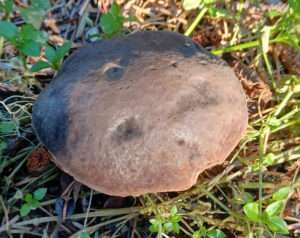 My subject for this example is a pored mushroom I found here on the Long Beach Peninsula last November. I’d seen them in passing, and even picked them when out foraging with a friend a few years ago, but hadn’t actually taken any home with me because I was usually already overwhelmed with king boletes (Boletus edulis), saffron milk caps (Lactarius deliciosus) and other autumn finds. But I do try to identify at least a few new species each season, and I chose to document this one a little more closely.
My subject for this example is a pored mushroom I found here on the Long Beach Peninsula last November. I’d seen them in passing, and even picked them when out foraging with a friend a few years ago, but hadn’t actually taken any home with me because I was usually already overwhelmed with king boletes (Boletus edulis), saffron milk caps (Lactarius deliciosus) and other autumn finds. But I do try to identify at least a few new species each season, and I chose to document this one a little more closely.
The Hunt Begins
When I came across my mystery mushroom in the field, I began with a physical examination. It was approximately three inches in diameter, and about three and a half inches tall. The top of the cap was dark brown with just a hint of a purplish hue, and bright yellow pores on the underside. The stipe was a remarkable yellow with streaks of magenta to red, fading to tan closer to the base, and slender in comparison to some other Boletaceae, such as B. edulis. I also noted that it was growing in soil on the edge of a conifer forest dominated by a mix of young shore pines (Pinus contorta var. contorta) and some Sitka spruce (Picea sitchensis). I picked a small number of these to take home with me.
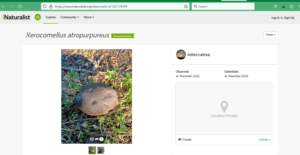 I also took a few photos and uploaded them to iNaturalist for initial identification suggestions. One should never use any identification app as your only tool for identifying mushrooms (or anything else), especially if you’re going to eat them. But it’s a good way to get some potential starting points for further research. As an aside, I like iNaturalist in particular because its algorithms have (as of this writing) over 127 million worldwide observations to sift through, and other iNaturalist users can visit your observations and either confirm your ID or suggest something different. Don’t automatically assume that the suggestions of either algorithms or humans is correct; always do your own research to verify whether that species is the best fit. You can even leave a comment on your observation, starting with “@whatevertheirusernameis”, and ask them why they chose the species they did over what you had initially suggested.
I also took a few photos and uploaded them to iNaturalist for initial identification suggestions. One should never use any identification app as your only tool for identifying mushrooms (or anything else), especially if you’re going to eat them. But it’s a good way to get some potential starting points for further research. As an aside, I like iNaturalist in particular because its algorithms have (as of this writing) over 127 million worldwide observations to sift through, and other iNaturalist users can visit your observations and either confirm your ID or suggest something different. Don’t automatically assume that the suggestions of either algorithms or humans is correct; always do your own research to verify whether that species is the best fit. You can even leave a comment on your observation, starting with “@whatevertheirusernameis”, and ask them why they chose the species they did over what you had initially suggested.
Ideally you want to get three views when you’re taking photos of a mushroom:
Bird’s Eye View: This is the top-down view, and usually the first thing you see when you spot a mushroom in the field. My mushroom wasn’t especially impressive, just a fairly solid brown, but it stood out amid the green clover (Trifolium repens) leaves and dried shore pine twigs.
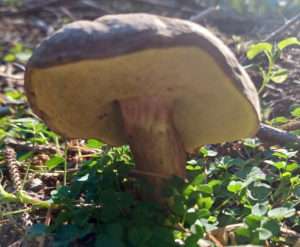
Bunny’s Eye View: Here you want to hunker down on the ground and take a picture from the mushroom’s side, as though you were a rabbit sitting next to it. Because the cap of my mushroom was turned upward some, I was able to get a two-for-one deal with both the side and the underside of the cap sufficient for iNaturalist’s purposes.
Bug’s Eye View: Finally, get a picture of the underside of the cap if your side view didn’t yield a clear look at it. This is often the most important shot of the mushroom, because what it has in its “undercarriage” can be an incredibly crucial diagnostic criterion. In this case, the presence of pores instead of gills marks this as a likely member of the family Boletaceae.
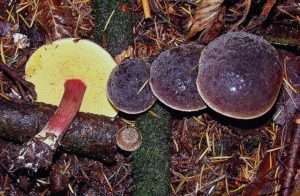
iNaturalist did suggest a few specific species to me, such as Xerocomellus atropurpureus, X. zelleri, and X. chrysenteron. (X. atropurpureus has only recently been differentiated as a separate species from X. zelleri.) Because they all had a similar appearance to my mushroom, I chose to simply categorize it at the family level (Boletaceae) for the time being.
Further Study at Home
One I got the mushrooms home, I grabbed one and washed off the dirt and duff, then sliced it in half. As expected, it was completely solid all the way through. Some older mushrooms do end up pockmarked with tunnels from insects and other little critters tunneling their way through, but these were nice and firm to the touch with no squishy spots. (By the way, I wasn’t in any danger from handling unknown mushrooms with my bare hands or cutting them up in my kitchen–you can find out why here!)
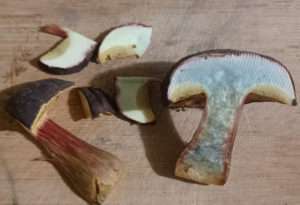
After about five minutes I noticed that the interior of the mushroom began to stain blue where it had been cut; this phenomenon is also known as bruising. Bruising is a fairly uncommon occurrence in mushrooms; if your mystery mushroom changes color a few minutes after being cut, broken, or otherwise damaged, that significantly narrows down the number of species it could potentially be.
If you’ve taken any of my foraging classes, you may have heard me say “Don’t eat any blue-staining boletes!” This is good advice–sometimes. Generally speaking, mushrooms in the genus Boletus that stain blue are not particularly edible, and some like B. satanas are downright toxic. (B. satanas has recently been reclassified as Rubroboletus satanas, but older field guides still list it as Boletus.) However, there are members of the wider Boletaceae family, of which Boletus is only one genus, that stain blue and are edible; X. zelleri is one example. It’s a lot easier (and safer) to just tell beginning foragers to avoid boletes that stain blue for the time being.
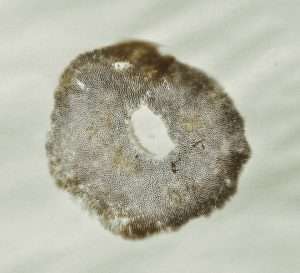
I sliced half of one cap into small pieces and took a bite of one while it was raw, then spit it out. The flavor was mild to unremarkable, with no immediate astringent or bitter flavor. I also cut the stipe off of one of the mushrooms so that I just had the cap with a nice, flat underside. I laid it pores side down on a piece of white printer paper, stuck it on a shelf away from drafts, and put a mixing bowl upside-down over it for a couple of days. That allowed spores to fall onto the paper to create a spore print. The spore color ended up being a nice, dark olive green, and the spores even recreated the structure of the pores on the paper.
Hitting the Books
Using all the information I had gathered about this mushroom–physical characteristics, location, substrate, season, etc.–I pulled out my field guides. I focused on the Boletaceae sections, since that’s the only common family of fungi that produce mushrooms that have distinct stipes and pores, and which grow out of the soil instead of on wood as with the various polypores and other shelf mushrooms.

Unsurprisingly, the three main species suggested by iNaturalist were well represented in my books and other resources, and differentiating among them became a matter of minor, but important, details. All three have a similar structure, size, color scheme, etc. But X. chrysenteron–the red-cracking bolete–gets its name because the top layer of the cap develops little pale-colored fissures in it as it matures. My mushrooms didn’t have that feature, and additionally X. chrysenteron is rather rare on the west coast.
X. zelleri is a west coast specialty, as is X. atropurpureus. Both of these species are known for bruising “inconsistently”, though consistently enough that I was able to find multiple pictures of both with bruising. So I couldn’t use the bruising on my mushrooms to rule either one out.
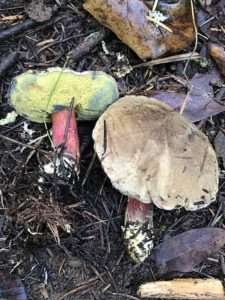
The also similar X. mendocinensis bruises very easily, but it has a cracked, often lighter-colored cap similar to that of X. chrysenteron, and the flavor is sometimes described as “acidic,” which didn’t describe my mushroom at all. Additionally, unlike some of the other contenders, X. mendocinensis generally isn’t found right on the Washington coastline where I am, mainly sticking to more inland areas.
I was able to rule out a few more Xerocomellus species with the same general color scheme, simply by comparing typical ranges. The “Explore” function on iNaturalist is a great tool in addition to field guide range maps as it tracks actual observations sorted with most recent first; you can even filter search results to only include Research Grade observations that have been verified by at least one other iNaturalist user. X. truncatus and X. dryophilus both don’t make it this far north on the coast, and the latter is only mycorrhizal with the coast live oak (Quercus agrifolia), which isn’t found around here, either. X. intermedius is an east coast mushroom, not found this far west. For sake of space I am not including pictures of these three species.
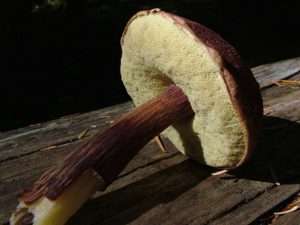
Finally, I did easily rule out Aureoboletus mirabilis, another mushroom I’ve found almost literally outside my door, because it generally has a darker, less vivid red on the stipe, and the cap doesn’t usually get that dark brown color on top. Be aware that not all A. mirabilis stipes are as dark as the one in the picture above, though, and some can have enough reticulation to look very similar to Xerocomellus species. I have noticed that the stipe of A. mirabilis is often proportionately longer than that of Xerocomellus mushrooms, and the upper range of its cap diameter is larger than that of Xerocomellus. A. mirabilis frequently has a marked depression where the cap meets the stipe. The upper surface of A. mirabilis‘ cap may have a scaly texture, patchier or rougher than the velvety texture of Xerocomellus. Finally, A. mirabilis may grow on decaying conifer wood as well as soil, while Xerocomellus species grow on soil.
Identification–Finally!
After look at the books and some mycology websites, comparing pictures from other people’s iNaturalist observations, I narrowed it down to X. atropurpureus and X. zelleri; again, the former until recently was considered to be the same species as the latter. So, unsurprisingly, they both match the description to a T, spore prints and all, and have significant overlap in their ranges, to include being found here on the coast. And both are considered to be edible, if not especially flavorful. Some foragers anecdotally note minor differences in the color and texture of the caps of the two species, but it may be that you have to get down to the genetic level to really tell the difference between the two.
That left me with a decision to make. X. atropurpureus is considered to be more common than X. zelleri, which makes the former the more likely species. And a while back another iNaturalist user suggested X. atropurpureus as the identification on my mushroom’s observation. So let’s just call it “probably X. atropurpureus” and take it as an example of how sometimes even with a lot of time and effort you don’t always manage to get a perfect identification down to species level.
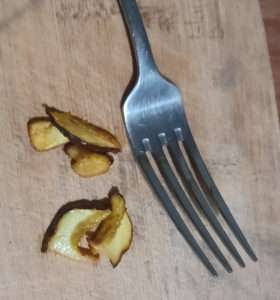
And yes, I did end up eating the mushrooms I picked, since both of the species I was considering for identification are edible, as were the various lookalikes. As is always best practice with a new mushroom that’s been confidently identified as an edible species, I cooked and ate just a few bites so that if I did have a reaction it would be a small reaction, and then waited a couple of days to make sure I didn’t get any gastrointestinal or other symptoms (there were none, thankfully.) I sautéed them in butter, which is my favorite way to introduce myself to a new mushroom, and found it to be rather pleasant and not overly strong with a soft but not slimy texture if you don’t overcook it. Some would call it bland or insipid, but I would use it as a nice vehicle for sauces and seasonings.
Summary
So, to recap (ha!), here’s my process of how to identify mushrooms:
- Make observations about the mushroom’s physical characteristics (color, texture, size/proportion, etc.), location (including substrate), season in which it has appeared, and any tree species or other mushrooms nearby.
- Take a few pictures (Bird’s Eye View, Bunny’s Eye View, and Bug’s Eye View) and do a quick upload to iNaturalist for initial species suggestions and, hopefully, recommendations from other iNaturalist users down the line.
- At home clean the mushroom to make sure there aren’t any colors or other details missed in the field, cut it open to observe whether it bruises or not, and take a spore sample.
-
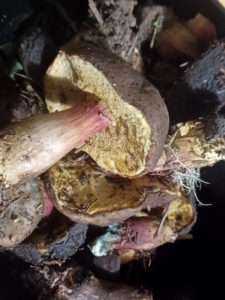
Another shot of my mushrooms, likely to be X. atropurpureus after taking into account the physical characteristics, typical range and mycorrhizal associates, and other traits of several very similar species in the genus Xerocomellus. Refer to field guides, websites, and other resources to gather more information about potential identifications for your mystery mushroom. Be very thorough, especially when poring over (pun totally intended) tiny details that differentiate two or more very similar species. This is also a good time to contact other foragers in person and/or online for further verification if you wish. (Feel free to contact me if you’d like my opinion on a mushroom you’ve found!)
- Never take any single source on its own when trying to determine a positive identification; instead, compile all the information, note any places where sources may disagree, and see where the evidence points most firmly. And if you end up getting stuck at the genus or even family level, that’s okay! Maybe you’ll find information later on that points toward something more specific, like my fellow iNaturalist user who nudged me toward X. atropurpureus and made me check my sources yet again.
- Make very, very sure you don’t eat anything you aren’t absolutely certain is an edible species; while I didn’t get myself down to a firm single species, the main contenders were all edible, there weren’t any dangerous lookalikes, and I felt confident taking the risk of eating a small portion. This is often not the case with other mystery mushrooms, and my usual practice is “when in doubt, throw it out,” so consider my decision here to be the exception rather than the norm for me, since I would like to someday be an old, rather than bold, mushroom hunter.
Sources
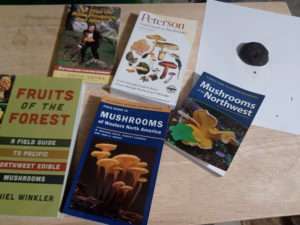 The following books and websites were particularly helpful in sussing out an identification for my mystery mushroom. They are by far not the only source materials out there, and I did refer to others along the way.
The following books and websites were particularly helpful in sussing out an identification for my mystery mushroom. They are by far not the only source materials out there, and I did refer to others along the way.
Arora, David (1991). All That the Rain Promises and More: A Hip Pocket Guide to Western Mushrooms.
Davis, Mike, Sommer, Robert, et. al. (2012). Field Guide to Mushrooms of Western North America.
Marrone, Teresa and Parker, Drew (2019). Mushrooms of the Northwest: A Simple Guide to Common Mushrooms.
McKnight, Karl, Rohrer, Joseph R., et. al. (2021). Peterson Field Guide to Mushrooms of North America.
Trudell, Steve and Ammirati, Joe (2009). Mushrooms of the Pacific Northwest.
Winkler, Daniel (2022). Fruits of the Forest: A Field Guide to Pacific Northwest Edible Mushrooms.
iNaturalist (especially the “Explore” function on the browser version of the site)
Did you enjoy this post? Consider taking one of my online foraging and natural history classes or hiring me for a guided nature tour, checking out my other articles, or picking up a paperback or ebook I’ve written! You can even buy me a coffee here!

Throughly enjoyed your process of mushroom identification. It was very informative and organized. Thanks so much. Mary Ann Seeger
I’m very glad you got a lot out of it–thank you for your kind words!